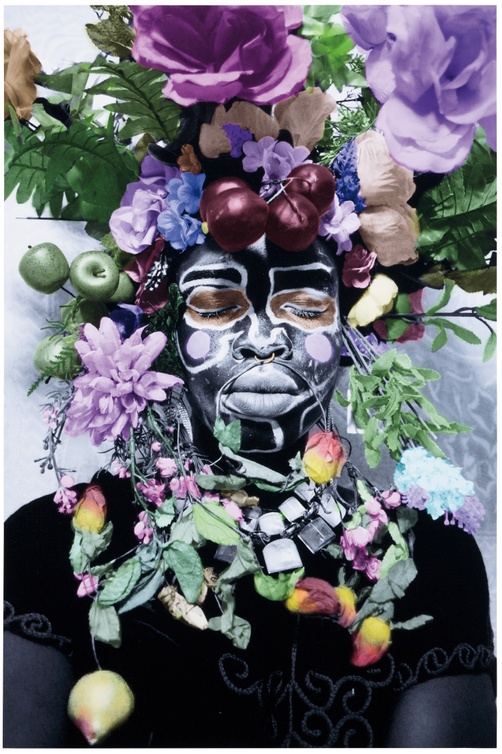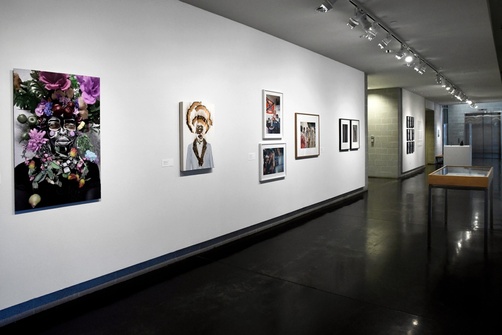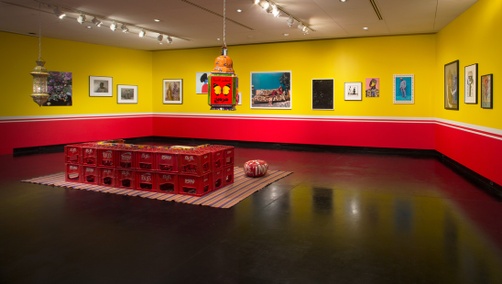
overall size: 45 x 30 in.
Installation views



Object Labels
Western gender ideologies, influenced by Christianity, perceive women to be “of the earth and body” and men to be “of the spirit and mind.” This notion, intended to subjugate women, is part of the continued colonization and cultivation of the female body. Given the patriarchal structure of Western civilization, it also implies the earth’s inherent inferiority to the heavens and to man. This same notion is wrapped up in the Western colonial thought that deemed African cultures as “primitive.” Black women bear a particularly heavy burden because of these stereotypes. They become subject to a colonial gaze that reduces them to savages and has been used to justify the exploitation of their bodies.
Atong Atem’s self-portrait subverts the notion that the Black female body exists to be exploited, cultivated, or consumed. She depicts herself with eyes closed, tranquilly enveloped by nature. By using herself as the subject, Atem has agency over her body and its relationship to the earth. She rejects the narrative of primitivism that has been imposed on Black women for centuries, positing herself and her body to be the “fruit of the earth” in a way she chooses.
The framework of ecosexuality depends on individuals welcoming the body-earth connection and eradicating an ideology that claims that “civilized” societies are above the earth and its labors. By exalting both herself and nature, Atem embodies this particular ecosexual principle.
–Caroline Coxe ’20
From the exhibition: Lover EarthArt and Ecosexuality (May 30 – August 23, 2020)
South Sudanese artist and writer Atong Atem explores postcolonial identities in the African diaspora. At a young age Atem realized that, like it or not, society dictates the ways in which one’s race and gender are understood. She is interested in using her photography to illuminate how Africans construct and reclaim identities for themselves in contemporary society. She is best known for her vibrant photographs featuring her friends and herself. Atem has named Malick Sidibé as one of her inspirations and has described her work as similar to his, being about “colour and texture and a kind of anti-minimalist approach to subject and sets.” This anti-minimalist approach is one that many other artists in Africa Pop Studio share, illuminating Sidibé’s influence on Africa and the diaspora. In this self-portrait, the artist has painted her face and framed it with plastic flowers and fruit. Atem Photoshops color onto the black-and-white image where the face paint and flowers exist. What is unique about it is that the artist has chosen to mask most of her face, making it less about her and more about the idea that black women are the fruit of the earth—they are born from the earth and are strong enough to sustain their communities.
Atong Atem was born in South Sudan and currently lives in Melbourne. Though she is known for her photography, she studied painting at Sydney College of the Arts, furthering her studies at the Royal Melbourne Institute of Technology. Her work can be found in i-D magazine as well as Okayafrica, and she was recently awarded the inaugural MELT Portrait Prize at Brisbane Powerhouse. She has been included in recent shows at Gertrude Contemporary in Melbourne and Red Hook Labs in Brooklyn.
From the exhibition: Africa Pop Studio (April 1 – April 23, 2017)
South Sudanese artist and writer Atong Atem explores and celebrates the complex identities of black bodies, particularly the effects of Colonial control over black bodies across the African diaspora. Displaying herself as the focal point of this portrait, eyes closed, arms by her side, Atem is tranquil yet powerful. Just like the apples and pears that surround her, she perceives black bodies, too, as the “fruit of the earth.” As a black queer woman, Atem uses her artwork as a way to challenge the discrimination and racism she experiences on a daily basis. Interested in subverting artwork that perpetuates white dominance, Atem places black bodies, her friends and her own, at the center of her work. She challenges the social construction of race that deems black bodies inferior, celebrating instead the beauty and value of those living on the margins. She believes that if human beings were the ones to construct race in the first place, they, too, can be the ones to demolish it.
–Eve Gertzman ‘20
From the exhibition: When and Where I Enter (October 20, 2018 – January 6, 2019)
Ongoing Research
Tang Collective Catalog
Hannah Traore
July 13, 2017




